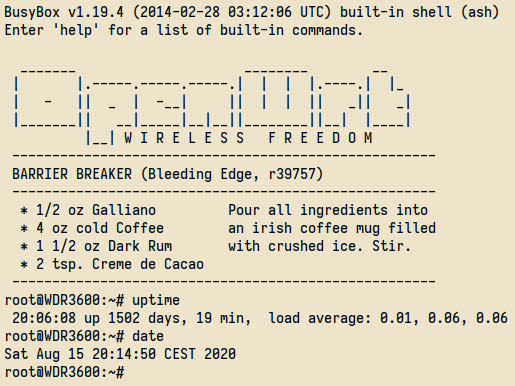September 15, 2020
Replacing OpenWrt by solyste
For the last past years, I have been using OpenWrt on a TP-Link WDR3600 in a secondary home. It allows me to connect an entire room to the ISP box downstairs using Wifi, and in that room I can rely on cables. It is much more simple than having to setup Wifi on all machines. Sometimes, it can't be done (OpenBSD). The WDR3600 had an unusual uptime: 1502 days. It does more than four years. Even if it was quite stable, I wanted to reinstall it especially because the userland was really old. I am pretty sure the busybox version (here 1.19.4) was vulnerable.

After working on my exciting project called solyste and creating a system the way I want it to be, going back to OpenWrt would be quite painful, IMHO. So, I finally decided to install solyste on my Turris Omnia, in order to replace OpenWrt on the WDR3600. Omnia hardware specifications are better and I know the platform in detail (from U-Boot to architecture).
When I started working on solyste, many people said the ideas were interesting but unfortunately, they also said it was just a concept. Since then, I attempted to improve its resilience to set up solyste on specific and critical environments. These days, it powers some highly critical gateways granting access to iDRAC or iLO networks and other servers managed by IPMI. It is not a concept anymore. In some specific aspects, we also do better than the other (64-bit kernels instead of 32-bit, 64-bit userland instead of 32-bit, improved security with read-only partitions, random default root password).
Here, the requirements are not so drastic, I only need Wifi,
IP forwarding, DHCP and a firewall. I will be able to
remotely backup my data on that system, using OpenSSH and
remote forwarding.
The backup filesystem will be encrypted with LUKS. In addition
to daemons you can find on a similar router setup, I will
activate Unbound for name resolution and OpenNTPD for NTP
server. Here the file build.conf:
SOL_NOINTERACTIVE=YES
SOL_OTHERPKGS="openntpd vnstat curl unbound monit cryptsetup libnl wpa_supplicant dnsmasq"
SOL_BUILD_SSHCLIENT=YES
SOL_HOSTNAME="omnia.solysterocks"The configuration is done. It's time to launch the entire solyste system build:
$ sh build.sh -c build.conf omnia
$ ./scripts/compress-fs omniaYou could ask why I launch ./scripts/compress-fs
at the end and you would be right. I now only use SquashFS
filesystem for the root partition. Even if it is sometimes less
practical, it improves a LOT the system reliability (power
outage, filesystem corruption, data loss, malicious access). You
just need to be careful before deploying the system. Why do I
like it SquashFS so much ? It has the following advantages:
- directly included in Linux kernel
- compression ratio with gzip is insane (around 41% in solyste)
- decompression with gzip is blazing FAST
- detect sparse files
- read-only filesystem
- filesystem is a file
- do not have to use
mkfscommand - install with
cat FILE.sqsh >/dev/PARTITION
In addition, I like the idea of having a "brand new" system
after every reboot. If it was running fine just after the
installation, you can be pretty sure it will behave exactly the
same after the boot. When I talk about compression ratio, here
the output to compare. solfs-omnia/ is the entire
system, solfs-omnia.sqsh is the same system
compressed with SquashFS and gzip :
$ du -sh solfs-omnia/ solfs-omnia.sqsh
22M solfs-omnia/
13M solfs-omnia.sqshThen, I had to copy this solfs-omnia.sqsh to
an USB key, before switching to Omnia rescue system. The eMMC
was partitioned like this :
$ fdisk -l
Disk /dev/mmcblk0: 7456 MB, 7818182656 bytes, 15269888 sectors
238592 cylinders, 4 heads, 16 sectors/track
Units: sectors of 1 * 512 = 512 bytes
Device Boot StartCHS EndCHS StartLBA EndLBA Sectors Size Id Type
/dev/mmcblk0p1 * 32,0,1 31,3,16 2048 1050623 1048576 512M 83 Linux
/dev/mmcblk0p2 32,0,1 31,3,16 1050624 3147775 2097152 1024M 83 LinuxThe first partition will be /boot in Ext4 and
the second partition will be the root SquashFS filesystem. As
U-Boot on Turris Omnia supports Ext4 and FAT32, I could have
also used FAT32 for the first partition. The resulting solyste
SquashFS file was simply "copied" to /dev/mmcblk0p2
with cat.
The previous U-Boot variable bootargs was the
following, when the entire system was formatted in Ext4 :
bootargs rootfstype=ext4 root=/dev/mmcblk0p1 rootdelay=2 rw console=ttyS0,115200 quietTherefore, it was changed to :
bootargs=rootfstype=squashfs root=/dev/mmcblk0p2 rootdelay=2 console=ttyS0,115200 quietPreviously, I was activating
OverlayFS
for /etc and /root. I could save my
specific configurations in a dedicated partitions and then,
mount it over the appropriate directories.
Eventually, it became harder to manage so I dropped this idea,
after applying it for years. Configurations are now directly
applied to the tree after the build. Here the previous OverlayFS
fstab :
$ cat /etc/fstab
LABEL=USERCONF /conf ext4 defaults,ro 0 2
# Overlay directories
overlay /etc overlay lowerdir=/conf/etc:/etc 0 0
overlay /root overlay lowerdir=/conf/root:/root 0 0The first boot was successful. I only needed to tweak one or two files prior being deployed in production. It is perfectly stable. After almost one month, here the output :
$ yss
HOST: omnia.solysterocks
DATE: 2020-09-12 06:41:59
OS: Linux
KERNEL: 5.4.58-SOLYSTE
UPTIME: 24 days
LOAD: 0.00 0.00 0.00
RAM: [*...................] 57(*)/24(o)/1006 MiB [5%(*)/2%(o)]
$ perpls -G
[+ +++ +++] crond uptime: 2138077s/2138077s pids: 224/223
[+ +++ +++] dnsmasq uptime: 2138077s/2138077s pids: 226/225
[+ +++ ---] getty-ttyS0 uptime: 2138077s/-s pids: 227/-
[+ +++ ---] klogd uptime: 2138077s/-s pids: 228/-
[+ +++ +++] monit uptime: 2138077s/2138077s pids: 230/229
[+ +++ +++] openntpd uptime: 2138077s/2138077s pids: 232/231
[+ +++ +++] sshd uptime: 2138077s/2138077s pids: 234/233
[+ +++ ---] syslogd uptime: 2138077s/-s pids: 235/-
[+ +++ +++] unbound uptime: 2138077s/2138077s pids: 238/237
[+ +++ +++] vnstatd uptime: 2138077s/2138077s pids: 241/240
[+ +++ ---] watchdog uptime: 2138077s/-s pids: 242/-
[+ +++ +++] wpa_supplicant uptime: 2138077s/2138077s pids: 247/245Actually, writing the firewall and testing it extensively, took more than two days which is a lot compared to the actual solyste build (~12 minutes). But that's another story…
To get started with solyste, visit the following page.